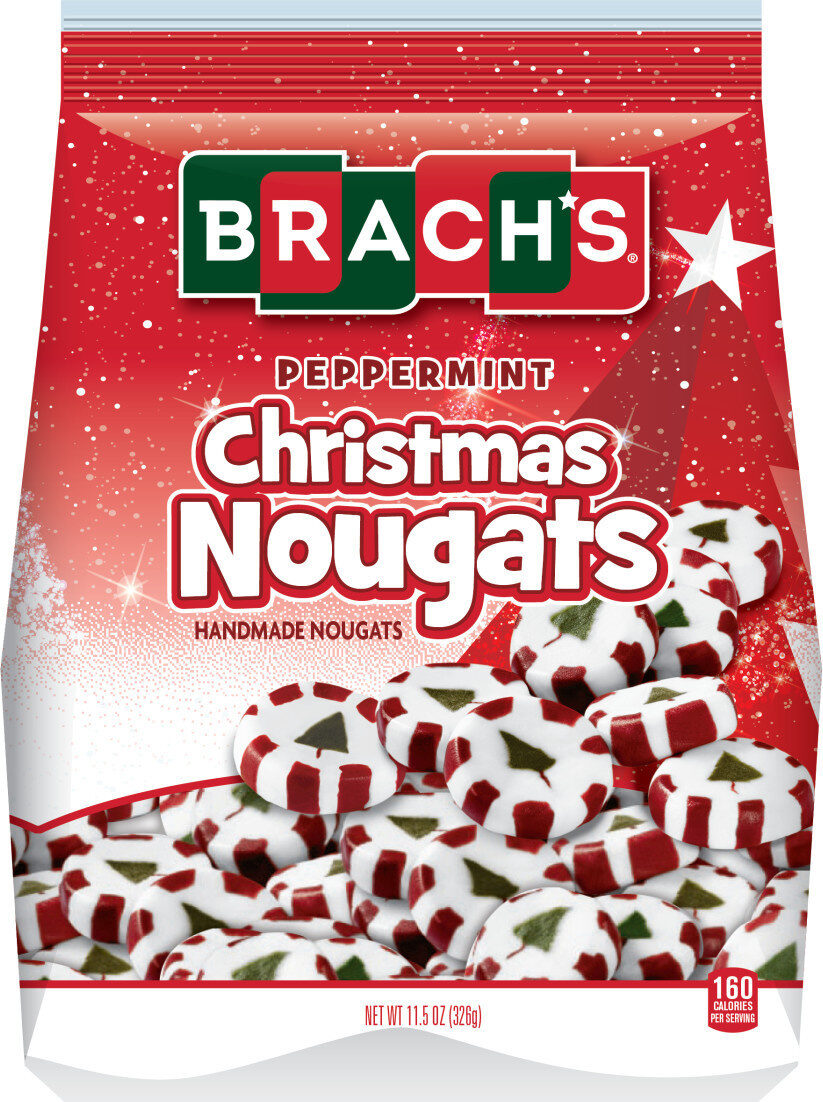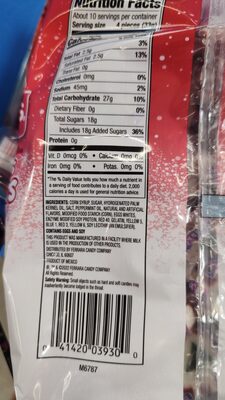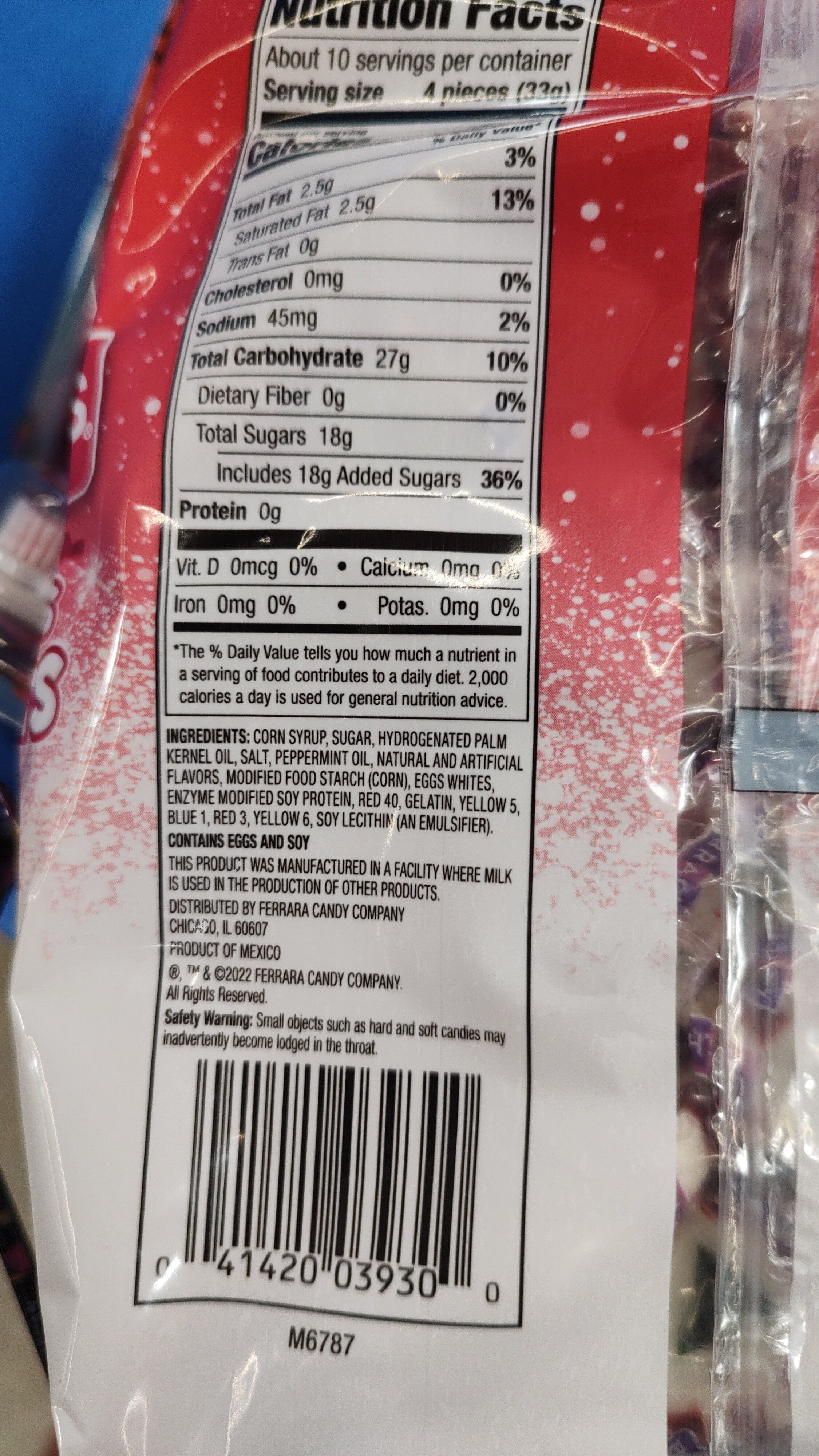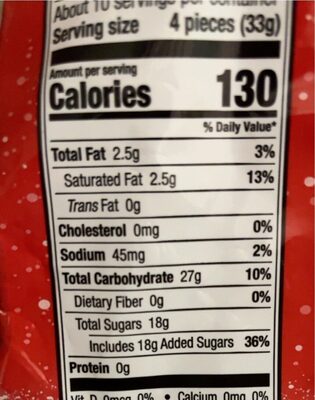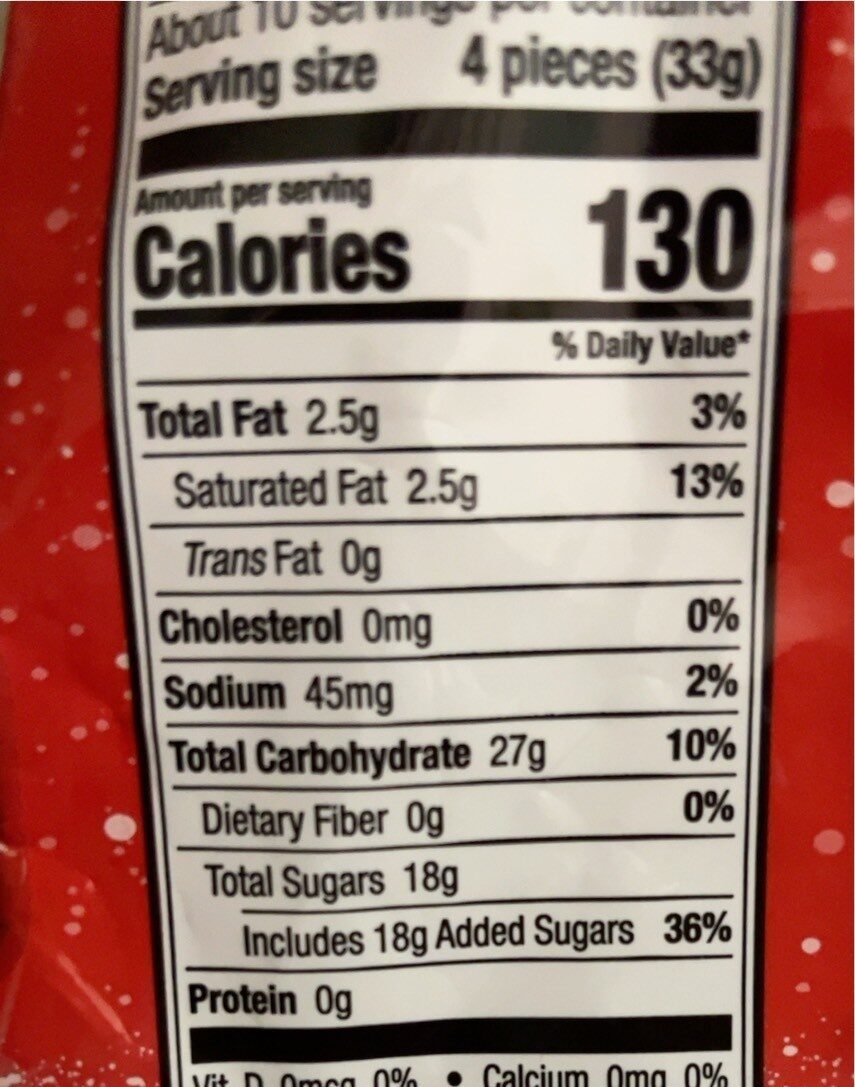Help us make food transparency the norm!
As a non-profit organization, we depend on your donations to continue informing consumers around the world about what they eat.
The food revolution starts with you!
Peppermint nougats christmas candy - Brach's
Peppermint nougats christmas candy - Brach's
This product page is not complete. You can help to complete it by editing it and adding more data from the photos we have, or by taking more photos using the app for Android or iPhone/iPad. Thank you!
×
Barcode: 0041420039300 (EAN / EAN-13) 041420039300 (UPC / UPC-A)
Brands: Brach's
Categories: Snacks, Sweet snacks, Confectioneries, Candies
Countries where sold: United States
Matching with your preferences
Health
Ingredients
-
24 ingredients
corn syrup, sugar, hydrogenated palm kernel oil, salt, peppermint oil, natural and artificial flavors, modified food starch (corn), eggs whites, enzyme modified soy protein, red 40, gelatin, yellow 5, blue 1, red 3, yellow 6, soy lecithin (an emulsifier). contains eggs and soy this product was manufactured in a facility where milk is used in the production of other products. m6787 ⓡtm & ©2022 ferrara candy company. all rights reserved. safety warning: small objects such as hard and soft candies may inadvertently become lodged in the throat. 41420 039300 ra 47Allergens: Eggs, Gelatin, Soybeans
Food processing
-
Ultra processed foods
Elements that indicate the product is in the 4 - Ultra processed food and drink products group:
- Additive: E102 - Tartrazine
- Additive: E110 - Sunset yellow FCF
- Additive: E127 - Erythrosine
- Additive: E129 - Allura red
- Additive: E133 - Brilliant blue FCF
- Additive: E322 - Lecithins
- Additive: E428 - Gelatine
- Ingredient: Emulsifier
- Ingredient: Flavouring
Food products are classified into 4 groups according to their degree of processing:
- Unprocessed or minimally processed foods
- Processed culinary ingredients
- Processed foods
- Ultra processed foods
The determination of the group is based on the category of the product and on the ingredients it contains.
Additives
-
E102 - Tartrazine
Tartrazine: Tartrazine is a synthetic lemon yellow azo dye primarily used as a food coloring. It is also known as E number E102, C.I. 19140, FD&C Yellow 5, Acid Yellow 23, Food Yellow 4, and trisodium 1--4-sulfonatophenyl--4--4-sulfonatophenylazo--5-pyrazolone-3-carboxylate-.Tartrazine is a commonly used color all over the world, mainly for yellow, and can also be used with Brilliant Blue FCF -FD&C Blue 1, E133- or Green S -E142- to produce various green shades.Source: Wikipedia
-
E110 - Sunset yellow FCF
Sunset Yellow FCF: Sunset Yellow FCF -also known as Orange Yellow S, or C.I. 15985- is a petroleum-derived orange azo dye with a pH dependent maximum absorption at about 480 nm at pH 1 and 443 nm at pH 13 with a shoulder at 500 nm. When added to foods sold in the US it is known as FD&C Yellow 6; when sold in Europe, it is denoted by E Number E110.Source: Wikipedia
-
E127 - Erythrosine
Erythrosine: Erythrosine, also known as Red No. 3, is an organoiodine compound, specifically a derivative of fluorone. It is cherry-pink synthetic, primarily used for food coloring. It is the disodium salt of 2‚4,5‚7-tetraiodofluorescein. Its maximum absorbance is at 530 nm in an aqueous solution, and it is subject to photodegradation.Source: Wikipedia
-
E129 - Allura red
Allura Red AC: Allura Red AC is a red azo dye that goes by several names, including FD&C Red 40. It is used as a food dye and has the E number E129. It is usually supplied as its red sodium salt, but can also be used as the calcium and potassium salts. These salts are soluble in water. In solution, its maximum absorbance lies at about 504 nm.Source: Wikipedia
-
E133 - Brilliant blue FCF
Brilliant Blue FCF: Brilliant Blue FCF -Blue 1- is an organic compound classified as a triarylmethane dye and a blue azo dye, reflecting its chemical structure. Known under various commercial names, it is a colorant for foods and other substances. It is denoted by E number E133 and has a color index of 42090. It has the appearance of a blue powder. It is soluble in water, and the solution has a maximum absorption at about 628 nanometers.Source: Wikipedia
-
E322 - Lecithins
Lecithins are natural compounds commonly used in the food industry as emulsifiers and stabilizers.
Extracted from sources like soybeans and eggs, lecithins consist of phospholipids that enhance the mixing of oil and water, ensuring smooth textures in various products like chocolates, dressings, and baked goods.
They do not present any known health risks.
-
E322i - Lecithin
Lecithins are natural compounds commonly used in the food industry as emulsifiers and stabilizers.
Extracted from sources like soybeans and eggs, lecithins consist of phospholipids that enhance the mixing of oil and water, ensuring smooth textures in various products like chocolates, dressings, and baked goods.
They do not present any known health risks.
Ingredients analysis
-
Palm oil
Ingredients that contain palm oil: Hydrogenated palm kernel oil
-
Non-vegan
Non-vegan ingredients: Egg white, E428Some ingredients could not be recognized.
We need your help!
You can help us recognize more ingredients and better analyze the list of ingredients for this product and others:
- Edit this product page to correct spelling mistakes in the ingredients list, and/or to remove ingredients in other languages and sentences that are not related to the ingredients.
- Add new entries, synonyms or translations to our multilingual lists of ingredients, ingredient processing methods, and labels.
If you would like to help, join the #ingredients channel on our Slack discussion space and/or learn about ingredients analysis on our wiki. Thank you!
-
Non-vegetarian
Non-vegetarian ingredients: E428Some ingredients could not be recognized.
We need your help!
You can help us recognize more ingredients and better analyze the list of ingredients for this product and others:
- Edit this product page to correct spelling mistakes in the ingredients list, and/or to remove ingredients in other languages and sentences that are not related to the ingredients.
- Add new entries, synonyms or translations to our multilingual lists of ingredients, ingredient processing methods, and labels.
If you would like to help, join the #ingredients channel on our Slack discussion space and/or learn about ingredients analysis on our wiki. Thank you!
-
Details of the analysis of the ingredients
We need your help!
Some ingredients could not be recognized.
We need your help!
You can help us recognize more ingredients and better analyze the list of ingredients for this product and others:
- Edit this product page to correct spelling mistakes in the ingredients list, and/or to remove ingredients in other languages and sentences that are not related to the ingredients.
- Add new entries, synonyms or translations to our multilingual lists of ingredients, ingredient processing methods, and labels.
If you would like to help, join the #ingredients channel on our Slack discussion space and/or learn about ingredients analysis on our wiki. Thank you!
: corn syrup, sugar, hydrogenated palm kernel oil, salt, peppermint oil, natural and artificial flavors, modified food starch (corn), eggs whites, enzyme modified soy protein, red 40, gelatin, yellow 5, blue 1, red 3, yellow 6, soy lecithin (an emulsifier), was manufactured in a facility where milk is used in the production of other products, m6787 ⓡtm and ©2022 ferrara candy company, all rights reserved, safety warning (small objects such as hard and soft candies may inadvertently become lodged in the throat, 41420 039300 ra 47)- corn syrup -> en:corn-syrup - vegan: yes - vegetarian: yes - ciqual_proxy_food_code: 31089 - percent_min: 10.871212121212 - percent_max: 100
- sugar -> en:sugar - vegan: yes - vegetarian: yes - ciqual_proxy_food_code: 31016 - percent_min: 0 - percent_max: 50
- hydrogenated palm kernel oil -> en:hydrogenated-palm-kernel-oil - vegan: yes - vegetarian: yes - from_palm_oil: yes - percent_min: 0 - percent_max: 33.3333333333333
- salt -> en:salt - vegan: yes - vegetarian: yes - ciqual_food_code: 11058 - percent_min: 0 - percent_max: 0.3409090909091
- peppermint oil -> en:peppermint-oil - vegan: yes - vegetarian: yes - ciqual_food_code: 11027 - percent_min: 0 - percent_max: 0.3409090909091
- natural and artificial flavors -> en:natural-and-artificial-flavouring - vegan: maybe - vegetarian: maybe - percent_min: 0 - percent_max: 0.3409090909091
- modified food starch -> en:modified-starch - vegan: yes - vegetarian: yes - ciqual_proxy_food_code: 9510 - percent_min: 0 - percent_max: 0.3409090909091
- corn -> en:corn - vegan: yes - vegetarian: yes - ciqual_food_code: 9200 - percent_min: 0 - percent_max: 0.3409090909091
- eggs whites -> en:egg-white - vegan: no - vegetarian: yes - ciqual_food_code: 22001 - percent_min: 0 - percent_max: 0.3409090909091
- enzyme modified soy protein -> en:enzyme-modified-soy-protein - percent_min: 0 - percent_max: 0.3409090909091
- red 40 -> en:e129 - vegan: yes - vegetarian: yes - percent_min: 0 - percent_max: 0.3409090909091
- gelatin -> en:e428 - vegan: no - vegetarian: no - percent_min: 0 - percent_max: 0.3409090909091
- yellow 5 -> en:e102 - vegan: yes - vegetarian: yes - percent_min: 0 - percent_max: 0.3409090909091
- blue 1 -> en:e133 - vegan: yes - vegetarian: yes - percent_min: 0 - percent_max: 0.3409090909091
- red 3 -> en:e127 - vegan: yes - vegetarian: yes - percent_min: 0 - percent_max: 0.3409090909091
- yellow 6 -> en:e110 - vegan: yes - vegetarian: yes - percent_min: 0 - percent_max: 0.3409090909091
- soy lecithin -> en:soya-lecithin - vegan: yes - vegetarian: yes - ciqual_food_code: 42200 - percent_min: 0 - percent_max: 0.3409090909091
- an emulsifier -> en:emulsifier - percent_min: 0 - percent_max: 0.3409090909091
- was manufactured in a facility where milk is used in the production of other products -> en:was-manufactured-in-a-facility-where-milk-is-used-in-the-production-of-other-products - percent_min: 0 - percent_max: 0.3409090909091
- m6787 ⓡtm and ©2022 ferrara candy company -> en:m6787-ⓡtm-and-2022-ferrara-candy-company - percent_min: 0 - percent_max: 0.3409090909091
- all rights reserved -> en:all-rights-reserved - percent_min: 0 - percent_max: 0.3409090909091
- safety warning -> en:safety-warning - percent_min: 0 - percent_max: 0.3409090909091
- small objects such as hard and soft candies may inadvertently become lodged in the throat -> en:small-objects-such-as-hard-and-soft-candies-may-inadvertently-become-lodged-in-the-throat - percent_min: 0 - percent_max: 0.3409090909091
- 41420 039300 ra 47 -> en:41420-039300-ra-47 - percent_min: 0 - percent_max: 0.17045454545455
Nutrition
-
Bad nutritional quality
⚠ ️Warning: the amount of fruits, vegetables and nuts is not specified on the label, it was estimated from the list of ingredients: 0This product is not considered a beverage for the calculation of the Nutri-Score.
Positive points: 0
- Proteins: 0 / 5 (value: 0, rounded value: 0)
- Fiber: 0 / 5 (value: 0, rounded value: 0)
- Fruits, vegetables, nuts, and colza/walnut/olive oils: 0 / 5 (value: 0, rounded value: 0)
Negative points: 22
- Energy: 4 / 10 (value: 1648, rounded value: 1648)
- Sugars: 10 / 10 (value: 54.545454545455, rounded value: 54.55)
- Saturated fat: 7 / 10 (value: 7.5757575757576, rounded value: 7.6)
- Sodium: 1 / 10 (value: 136.36363636364, rounded value: 136.4)
The points for proteins are not counted because the negative points are greater or equal to 11.
Nutritional score: (22 - 0)
Nutri-Score:
-
Nutrient levels
-
Fat in moderate quantity (7.58%)
What you need to know- A high consumption of fat, especially saturated fats, can raise cholesterol, which increases the risk of heart diseases.
Recommendation: Limit the consumption of fat and saturated fat- Choose products with lower fat and saturated fat content.
-
Saturated fat in high quantity (7.58%)
What you need to know- A high consumption of fat, especially saturated fats, can raise cholesterol, which increases the risk of heart diseases.
Recommendation: Limit the consumption of fat and saturated fat- Choose products with lower fat and saturated fat content.
-
Sugars in high quantity (54.5%)
What you need to know- A high consumption of sugar can cause weight gain and tooth decay. It also augments the risk of type 2 diabetes and cardio-vascular diseases.
Recommendation: Limit the consumption of sugar and sugary drinks- Sugary drinks (such as sodas, fruit beverages, and fruit juices and nectars) should be limited as much as possible (no more than 1 glass a day).
- Choose products with lower sugar content and reduce the consumption of products with added sugars.
-
Salt in moderate quantity (0.341%)
What you need to know- A high consumption of salt (or sodium) can cause raised blood pressure, which can increase the risk of heart disease and stroke.
- Many people who have high blood pressure do not know it, as there are often no symptoms.
- Most people consume too much salt (on average 9 to 12 grams per day), around twice the recommended maximum level of intake.
Recommendation: Limit the consumption of salt and salted food- Reduce the quantity of salt used when cooking, and don't salt again at the table.
- Limit the consumption of salty snacks and choose products with lower salt content.
-
-
Nutrition facts
Nutrition facts As sold
for 100 g / 100 mlCompared to: Candies Energy 1,648 kj
(393 kcal)+12% Fat 7.576 g +343% Saturated fat 7.576 g +675% Carbohydrates 81.818 g -1% Sugars 54.545 g -2% Fiber 0 g -100% Proteins 0 g -100% Salt 0.341 g +168% Fruits‚ vegetables‚ nuts and rapeseed‚ walnut and olive oils (estimate from ingredients list analysis) 0 %
Environment
-
Eco-Score D - High environmental impact
⚠ ️Select a country in order to include the full impact of transportation.The Eco-Score is an experimental score that summarizes the environmental impacts of food products.→ The Eco-Score was initially developped for France and it is being extended to other European countries. The Eco-Score formula is subject to change as it is regularly improved to make it more precise and better suited to each country.Life cycle analysis
-
Average impact of products of the same category: B (Score: 62/100)
Category: Candies, all types
Category: Candies, all types
- PEF environmental score: 0.41 (the lower the score, the lower the impact)
- including impact on climate change: 1.73 kg CO2 eq/kg of product
Stage Impact Agriculture
78.2 %Processing
10.7 %Packaging
5.5 %Transportation
4.5 %Distribution
1.1 %Consumption
0.0 %
Bonuses and maluses
-
Missing origins of ingredients information
Malus: -5
⚠ ️ The origins of the ingredients of this product are not indicated.
If they are indicated on the packaging, you can modify the product sheet and add them.
If you are the manufacturer of this product, you can send us the information with our free platform for producers.
-
Ingredients that threatens species
Malus: -10
Contains palm oil
Tropical forests in Asia, Africa and Latin America are destroyed to create and expand oil palm tree plantations. The deforestation contributes to climate change, and it endangers species such as the orangutan, the pigmy elephant and the Sumatran rhino.
-
Missing packaging information for this product
Malus: -15
⚠ ️ The information about the packaging of this product is not filled in.⚠ ️ For a more precise calculation of the Eco-Score, you can modify the product page and add them.
If you are the manufacturer of this product, you can send us the information with our free platform for producers.
Eco-Score for this product
-
Impact for this product: D (Score: 32/100)
Product: Peppermint nougats christmas candy - Brach's
Life cycle analysis score: 62
Sum of bonuses and maluses: -30
Final score: 32/100
-
Carbon footprint
-
Equal to driving 0.9 km in a petrol car
173 g CO² per 100g of product
The carbon emission figure comes from ADEME's Agribalyse database, for the category: Candies, all types (Source: ADEME Agribalyse Database)
Stage Impact Agriculture
52.3 %Processing
19.5 %Packaging
15.7 %Transportation
11.6 %Distribution
1.0 %Consumption
0.0 %
Packaging
-
Missing packaging information for this product
⚠ ️ The information about the packaging of this product is not filled in.Take a photo of the recycling information Take a photo of the recycling information
Transportation
-
Origins of ingredients
Missing origins of ingredients information
⚠ ️ The origins of the ingredients of this product are not indicated.
If they are indicated on the packaging, you can modify the product sheet and add them.
If you are the manufacturer of this product, you can send us the information with our free platform for producers.Add the origins of ingredients for this product Add the origins of ingredients for this product
Threatened species
-
Contains palm oil
Drives deforestation and threatens species such as the orangutan
Tropical forests in Asia, Africa and Latin America are destroyed to create and expand oil palm tree plantations. The deforestation contributes to climate change, and it endangers species such as the orangutan, the pigmy elephant and the Sumatran rhino.
Report a problem
-
Incomplete or incorrect information?
Category, labels, ingredients, allergens, nutritional information, photos etc.
If the information does not match the information on the packaging, please complete or correct it. Open Food Facts is a collaborative database, and every contribution is useful for all.
Data sources
Product added on by kiliweb
Last edit of product page on by wolfgang8741.
Product page also edited by inf, teolemon, yuka.sY2b0xO6T85zoF3NwEKvlh1WacGFmwv4MTHni1KR3IqrC8XlXYxT3YjVHao.

